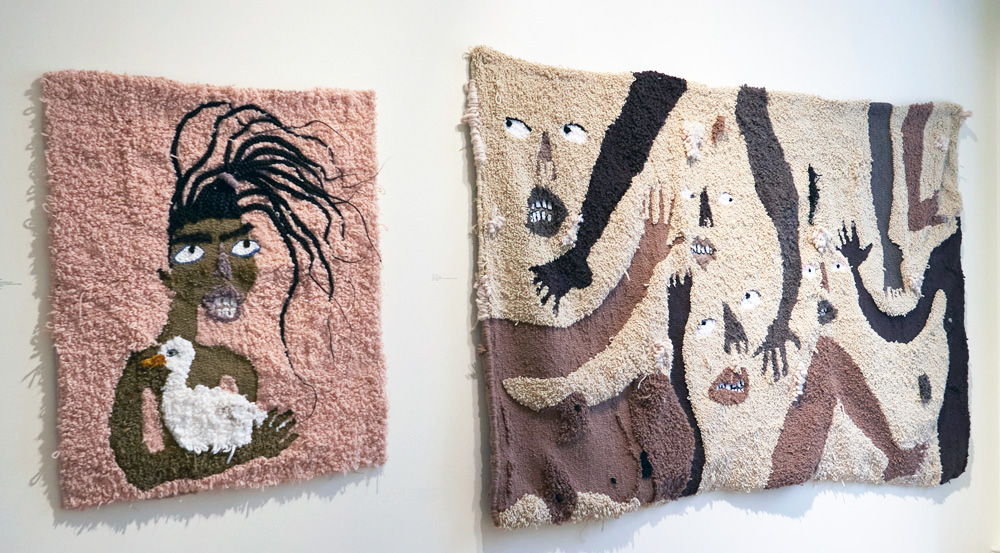
Anya Paintsil, installation view, 1-54 Contemporary African Art Fair, London 2020. Photo: Rocio Chacon.
Somerset House, London
8-10 October 2020
by CHRISTIANA SPENS
The first international art fair dedicated to contemporary art from Africa and its diaspora, this year’s eighth edition featured an impressive array of work by 110 emerging artists, represented by 30 galleries – a stripped-back, but no less dazzling collection of new work. From intricate, cartographic commentaries of current affairs by Abu Bakarr Mansaray to moving family portraits in yarn and hair by Anya Paintsil, this year’s 1-54 showcased a brilliantly diverse and exciting range of new perspectives on modern life and African identity.
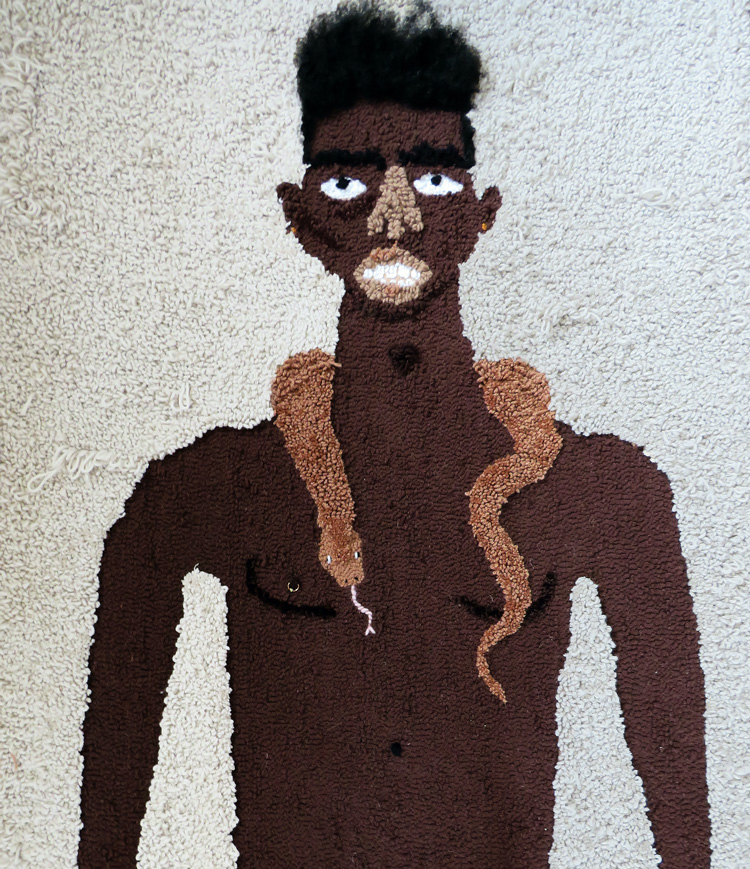
Anya Paintsil, Shackles the Snake, 2020. Acrylic, wool, human hair, synthetic hair and titanium on hessian, 134.6 x 134.6 cm. Courtesy of Ed Cross Fine Art.
Paintsil, a Welsh-Ghanaian artist (b1993), who was present at her solo exhibition at the fair, explores race and gender through her textile-based practice, using materials including cotton, acrylic weaves and her hair to confront issues of violence, identity and power dynamics. Playful yet complex and stirring, her intricate, semi-sculptural tapestries reclaim and subvert traditionally feminine pursuits to expose domestic strife and complex maps of identity and personhood. Strikingly original takes on the “family portrait”, these tapestries evoke tenderness and strength in equal measure, exhibiting exceptional discipline and self-awareness, and creating a space for reflection on human materiality, fragility and familial intimacy. Having graduated only this year from Manchester School of Art, Paintsil is one to watch.
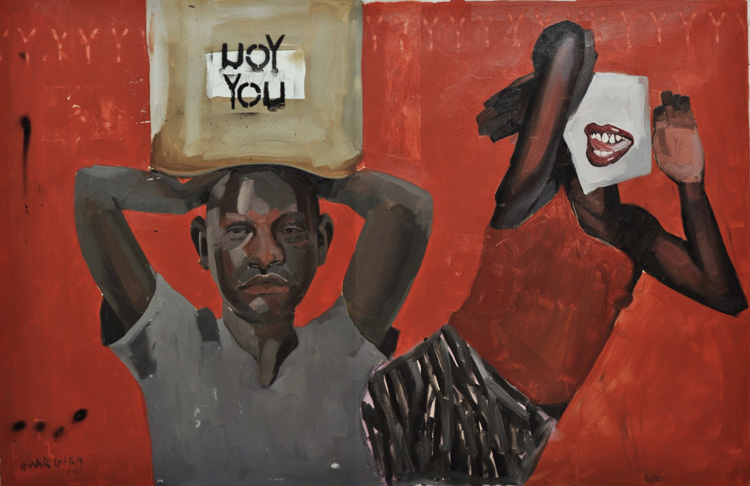
Omar Gabr, Untitled, 2019. Oil on canvas, 92 x 40 cm. Courtesy Ubuntu Art Gallery.
Another exciting young artist is the self-taught Egyptian Omar Gabr (b1999), whose playful, sardonic and charismatic self-portraits possess a vibrancy, warmth and weight that is truly magnetic. Reminiscent of the styles of Peter Doig and Jean-Michel Basquiat, Gabr’s portrait – painted on to his bedroom door – of a cross-dresser, smiling sweetly and yet wryly, strong and yet coy, seems to block the doorway while at the same time symbolising a new destination, a door about to open into a new place. Gabr’s work is thrillingly present, vivid and provocative. In his other work here – three different-sized paintings placed as a sort of misshapen triptych – the figure is gleeful, and then downcast and subdued. Rubbish is piled on the floor in front of him, spilling from one painting to the next; disembodied hands and a heeled leg seem to emerge from this wasteful chaos.
In a solo exhibition with Berman Contemporary, the young South African artist DuduBloom More (b1990), from Soweto, Johannesburg, presented intricate, delicate works on paper, using thread, pen and ink, to invoke the artist’s sense of anxiety surrounding the current pandemic. “In the beginning, I felt hopeless,” she said. “The uncertainty of the future was overwhelming. The restrictions were unsettling. Knowing that there would be a period of mass death was depressing. I had to make a mental decision not to sink into all the fear and confusion, in the best way I knew how: creating with the purpose of staying present. Through this ongoing process, and in the body of work, there are moments that are difficult, but soft, too. It reflects the constraint and what we now know as movement.” In her tiny works, in which constellations of embroidered shapes take form in red and black, this sense of ordering chaos, or anxiety, and finding a sort of beauty in the present, and in concentration itself, is clear and striking.
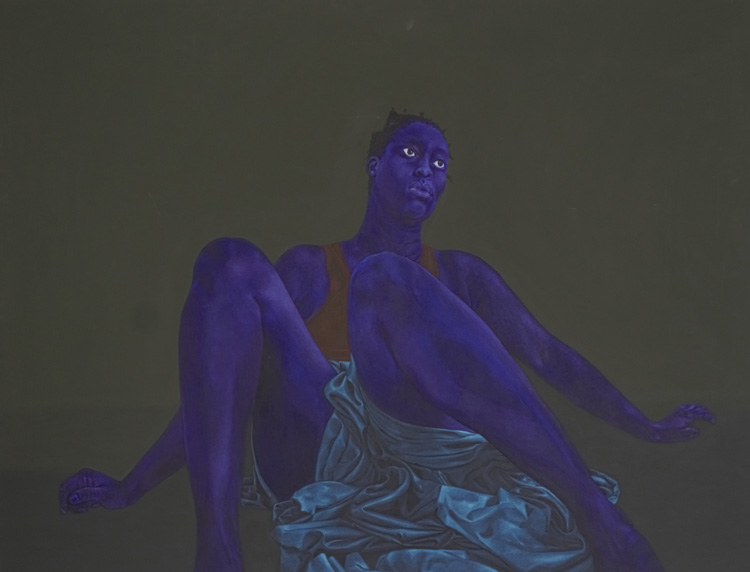
Stacey Gillian Abe, Sleeping girl 2, 2020. Acrylic on canvas, 96 x 124 cm. Courtesy Afriart.
At the Gallery of Everything’s stall, Mansaray’s fascinating cartographic drawings also dealt with the theme of disease. They were presented on large tables, behind glass, not only allowing visitors to see the intricate works (such as Julumbu, 2018) up close, but also ensuring social distancing in a very 2020 fashion. An independent image-maker, scientist, inventor, commentator and Afro-futurist, Mansaray powerfully captures the zeitgeist in his modern maps, showing vast connected shapes, ideas and words, which observe the links between Ebola and war, life and machinery.
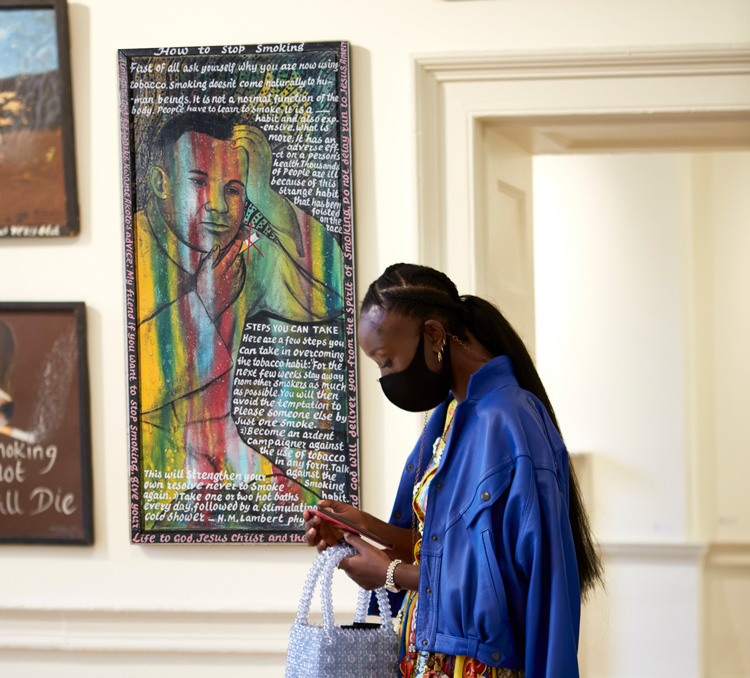
Gallery of Everything, installation view, 1-54 Contemporary African Art Fair, London 2020. Photo: Rocio Chacon.
Ghanaian artist Kwame Akoto (b1959), who goes by the pseudonym Almighty God, is also represented by the Gallery of Everything. A professional sign-painter and lay-preacher, the artist, whose hand-painted signs provide a moving, humorous sort of African pop art, shows a demure-looking dog smoking a cigarette, against the words “I will stop Smoking/If not I will die”, alongside another, of two people in profile also smoking, with the words “Stop it! Drug abuse/Dangerous”. The circularity, absurdity and frustration of addiction is conveyed in this sardonic, strangely moving manner; none of them is stopping at all.
A third artist presented by the Gallery of Everything was Johnson Weree (b1970), who began his practice in war-torn Liberia before moving to the Netherlands. He created rows of colourful, lively and intricate portraits. While there is a certain naivety to their style, the figures are wizened and worldly; their moods intangible and weighty. Along with the neighbouring maps, dogs and icons, they are hard to leave, creating a colourful, moody magnetism.
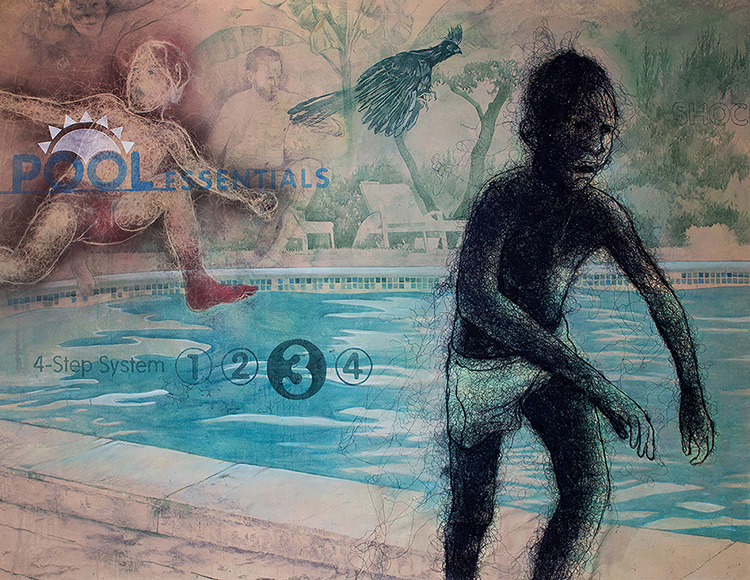
Andrew Kayser, Bittersweet Blue and the Sudden Rapture, 2019. Thread, charcoal, ink and spray paint on canvas, 170 x 220 cm. Courtesy THK Gallery.
Elsewhere, there were many more examples of vivid, moving and timely work. The Ugandan artist Stacey Gillian Abe (b1990) creates enthralling figures in dark violet against intense, shadowy greens, exploring unsettling narratives about identity, gender, spirituality and mysticism. Andrew Kayser (b1977, South Africa), at THK Gallery, shows a collection of fine, detailed drawings, that revel in their ambiguity and intricacy. Jean David Nkot (b1989, Cameroon), at Jack Bell Gallery, meanwhile, addresses themes surrounding trans-African migration, combining detailed portraits with layers of complex cartographic information, and producing sensual, realistic and sprawling visions of people facing overwhelming and unknown situations, uprooted and yet determined. By humanising the exiled and dispossessed, he flips the usual narrative about refugees and migrants, and gives people back their humanity and complexity. Across the fair, these and other works create a powerful mood of strength, integrity and quiet resistance; it is hard to leave.